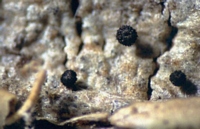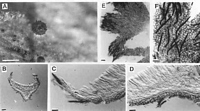|
 Pirottaea horoeka Pirottaea horoeka
BiostatusPresent in region - Indigenous. Endemic
Images (click to enlarge)
Owner: Peter Johnston | 
Caption: Fig. 3 Pirottaea horoeka (A, F, PDD 68333; B-D, PDD 62703; E, PDD 41947): A,
apothecium; B, apothecium in vertical section; C, upper margin of apothecium in vertical
section; < | 
Caption: Fig. 4 Pirottaea horoeka (PDD 68333): A, asci; B, apex of paraphyses; C, ascospores; D,
setae in surface view. |
Article: Johnston, P.R. (1998). Four new Pirottaea species from New Zealand. New Zealand Journal of Botany 36(4): 645-652 (http://www.rsnz.org/publish/abstracts.php).
Description: Apothecia developing on fallen leaves of Pseudopanax crassifolius (Araliaceae). Apothecia 0.4-0.7 mm diam., about 0.5 mm high, urceolate with short, narrow stipe. Receptacle translucent whitish or yellowish beneath dense covering of stiff, black, appressed setae, setae most numerous around margins of ascoma; hymenium white.
Ectal excipulum up to 20 µm wide at sides of receptacle in vertical section, comprising rows of globose to angular cells 6-10 µm diam., with thin, brown walls. Cells becoming brick-shaped to rectangular near margin of ascoma, and ending in more or less free, hair-like elements. Setae arising directly from excipular cells, 50-70 x 5.5-7.5 µm, fusoid, tapering to more or less acute apex, more or less straight, 1-3-septate, with walls very dark and very thick, and septa often difficult to see. Medullary excipulum up to 10 µm wide, of 3 or 4 layers of narrow-cylindric cells 2.5-3 µm diam., with hyaline walls, thin-walled at sides of receptacle, the walls thicker and possibly gelatinised in stipe, these thicker-walled cells dextrinoid in Meltzer's reagent. Ends of medullary elements more or less free and inward projecting in portion of apothecial wall extending above hymenium.
Paraphyses 1.5 µm diam., expanding slightly to 2.5-3 µm diam. at subclavate apex, about same length as the asci. Asci 45-55 x 6.5-7 µm, cylindric to subclavate, apex rounded, wall thickened at apex with small, intense amyloid ring, 8-spored. Ascospores 7-9 x 2-2.5 µm, oblong-elliptic to elliptic, slightly wider in upper half, 0-septate, hyaline.
Notes: ETYMOLOGY: the Maori name for the host plant.
NOTES: P. horoeka is distinguished from the other New Zealand species by the shape and size
of the setae and the ascospores, as well as host substrate.
|